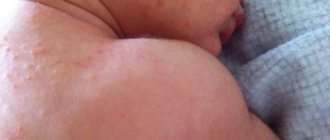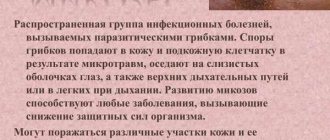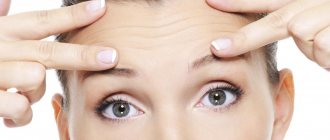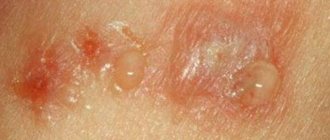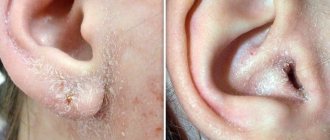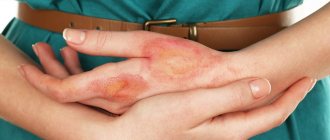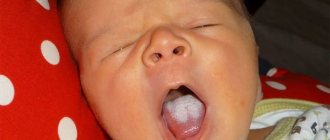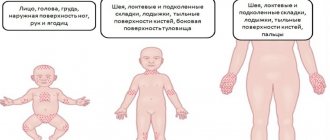Causes of seborrhea in children
Seborrhea can appear in a child at any age, and the reasons for newborns and, for example, adolescents will be different. Often the occurrence of seborrhea is associated with the state of health of the child.
Causes of seborrhea in newborns:
- Sweating.
Young mothers who have given birth to their first child are often too anxious about the health of their child. They put warm overalls on him, even if the air temperature in the apartment is optimal. - Improper nutrition of a nursing mother or the child herself .
Excessive consumption of fatty foods has a great impact on the functioning of the sebaceous glands. - Consumption of cosmetics and shower products with allergenic additives (strawberries, wild strawberries, cocoa, chocolate, etc.).
Various hygiene products for children are often made using berries, fruits and other products that can give a sweetish aroma, but not all of them are safe.
In adolescent children (12-15 years old), hormonal levels are unstable, which can also trigger the appearance of seborrhea.
Improper functioning of the glands in this case will be caused by:
- Puberty .
During this period, the secretion of glands increases, as the vegetative-endocrine system of the body is rebuilt. In this case, physiological seborrhea occurs in the child, which can end on its own by adolescence (15-20 years). - Congenital hormonal disorders .
In children, insufficient or, conversely, excessive production of hormones can affect the development of various endocrine, skin and other diseases, including dermatitis. - Vitamin H deficiency (biotin).
This vitamin is also called the “beauty vitamin.” Due to the large amount of sulfur in the composition, it has a positive effect on the skin, hair and nails, and also participates in the metabolism of fats in skin and hair cells.Biotin deficiency often leads to seborrhea and hair loss.
- Long-term use of certain medications.
Anabolic steroids and testosterone, which boys can take in adolescence, negatively affect the functioning of the sebaceous glands. In girls, seborrhea occurs with excessive use of progesterone and some other hormonal agents.
- Diseases:
- lethargic encephalitis (“sleeping sickness”);
Itsenko-Cushing's disease (neuroendocrine disease);
- Parkinson's disease (neurological disorder).
- Mental disorders:
- affective insanity;
- various infectious psychoses;
- epilepsy;
- schizophrenia.
- Hereditary factor . In some cases, the cause of seborrhea in a child is the presence of this problem in one of the parents.
Traditional methods
Tested by time and in effectiveness are not inferior to the means invented in our time. Of course, they should not be used in advanced cases.
Traditional medicine knows how to get rid of scabs or dandruff. To do this, use tomato juice and mix it with vegetable oil in equal parts. Wipe the affected areas with a warm mixture. An ointment based on lard, with the addition of salt and sulfur, is also recommended. In folk practice, everyone’s favorite drink, bread kvass, is widely used. It is useful not only when consumed internally, but also helps to heal from crusts on the surface of the skin.
In combination with drug treatment, the use of decoctions of St. John's wort, oak and chamomile will be a good help. Collections of celandine, string and calendula will greatly alleviate the patient’s condition. And tar soap will be useful not only during the course of treatment, but also in the future, to prevent relapses. Herbal rinses will help not only sick hair, but also preserve the beauty of healthy hair.
It is better to discuss all the causes and treatment of the disease with your doctor so as not to harm your skin. An ordinary scratch can lead to dire consequences. The question of what happened to the skin and how to treat it should always be asked to a specialist.
Symptoms
Most often, those areas of the skin where a large number of sebaceous glands are located are affected by seborrheic dermatitis.
Areas that may be affected by seborrhea:
- scalp and forehead;
- ears;
- interscapular region;
- nasolabial triangle;
- armpits.
In these places, babies develop fatty scaly crusts of white or yellowish color. Sometimes in newborn babies, seborrhea appears in the inguinal folds, as well as on the skin of the arms and legs.
Some parents confuse seborrhea with a crust on a healing fontanel. Consult your doctor to clarify your diagnosis!
Symptoms in newborns:
- thickening of the stratum corneum of the skin;
- oily sheen on the skin;
- many small lesions;
- skin itching (not always pronounced);
- hair loss or thinning;
- dandruff.
Seborrhea in a child is often confused with dandruff and due attention is not paid to skin treatment . This leads to severe forms of the disease, which, in turn, affect other body systems.
If treatment is not treated promptly, the child may develop weakness, nausea, loss of appetite, restless sleep, and diarrhea.
Mechanical removal of crusts
A common method of removing crusts is mechanical. Before you begin, you need to soak the peeling areas with oils to soften them.
During the procedure, the following recommendations must be followed:
- It is important for parents to wash their hands thoroughly before beginning to remove scabs.
- 1 hour before water procedures, rub regular baby oil into the scalp, just be sure to warm it up before doing this. Regular Vaseline will also work for this.
- Tie a warm cap and wait 5-6 hours.
- Before bathing, you need to remove the hat and use a soft baby brush to remove the crusts.
- Give the child a bath, and then brush again, as his scalp is well steamed. This procedure can be carried out several times until all peeling is removed.
When performing such procedures, seborrheic crusts should not be exfoliated dry. There is a risk of injury to the baby’s delicate tissues and infection in microscopic scratches.
Mechanical removal of dandruff on a child’s head does not always lead to good results. You need to perform at least 2-3 procedures to get rid of scales. In addition, often a new crust appears on the head again, since the original cause of their appearance has not been eliminated.
Photo
Take a look at what the disease looks like in the photo:
First aid at home
Treating children with folk remedies at home can be not only useless, but also dangerous, so when the first symptoms appear, it is better to immediately consult a specialist.
However, even before the trip, parents can try to independently identify the cause of the disease. This can be done by paying special attention to the functioning of the endocrine system, gastrointestinal tract and immunity of the child, as well as by reviewing the diet of the nursing mother.
also check their child’s hygiene products for the presence of allergens and exclude those that could cause this form of dermatitis.
Various special ointments and shampoos should not be purchased before visiting a doctor - only he will be able to select a product taking into account the age of the child, the characteristics of his skin and the disease itself.
Disease prevention
Medicine does not stand still. It is thanks to this that many ways to prevent this or that disease have appeared.
To prevent the appearance of seborrhea in a child, you must follow some rules:
- hygiene. This is extremely necessary for the baby; the head must be constantly clean and dry;
- proper care. It is necessary to systematically use special children's shampoos;
- soft brush. The child's hair should be combed several times a day with a properly selected brush.
There is no need to self-medicate. Be sure to see a doctor to avoid unpleasant consequences
After all, it is important for every woman that her baby is cheerful and healthy. And all that is required is basic hygiene standards, care and love!
Diagnostics
A diagnostic examination is carried out by a dermatologist or trichologist. A trichologist is a dermatologist who specializes in treating diseases of the scalp and hair.
To confirm the diagnosis, the following measures must be taken::
Collect anamnestic data by interviewing parents.
- Identify risk factors and causes.
- Collect a biochemical blood test and, in the case of adolescents, a hormone test.
- Examine the affected areas of the skin.
After confirming the diagnosis, the doctor prescribes: treatment, diet and necessary physiotherapeutic procedures.
Folk remedies for treatment
There are a number of ways to combat seborrhea that are of folk origin.
It is worth remembering that not all types of traditional medicine may be suitable for a small child!
Nettle
For this recipe, you need to pour 100 grams of nettle leaves (chopped) with one and a half liters of water and the same amount of vinegar. All this should be cooked for thirty minutes. Afterwards it is filtered and left for a while to cool. This decoction is intended for washing the baby’s head before bed; soap cannot be used.
Chamomile
Two tablespoons of chamomile are poured into one liter of water, boil for about 5 minutes. This decoction serves as a rinse if seborrhea is oily.
Tansy
For treatment you will need a tincture of tansy flowers. You can use this recipe to rinse your baby's hair. Pour boiling water over 100 g of tansy and let it brew for 30-40 minutes.
Tar soap or ichthyl soap. It is very useful to use one or another soap as shampoo once every seven days.
